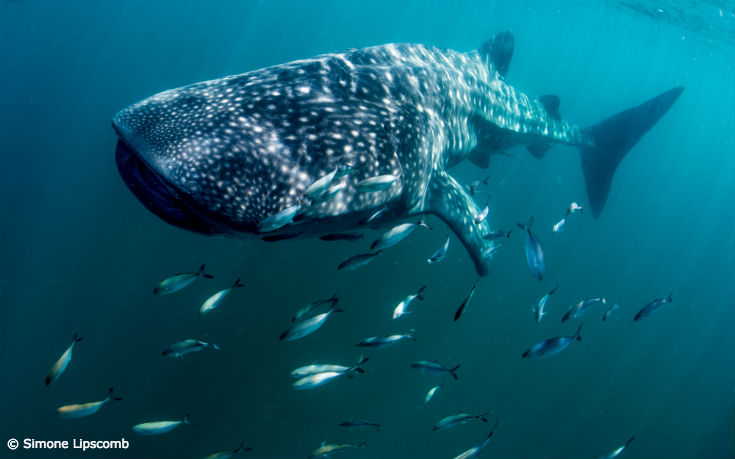Whale Sharks Move onto the Endangered List
Published by Ocean Conservancy

Written by Dr. Alistair Dove
You may have seen in the press the recent announcement from the International Union for the Conservation of Nature, that whale sharks (along with the enigmatic wing head shark) have been downgraded from Vulnerable to Endangered on the IUCN Red List. I thought it might help to explain exactly what that means, so I’ve done it as a sort of Frequently Asked Questions (FAQ):
What’s “the IUCN Red List”?
The Red List is a sort of master-file about the conservation status of different species. As you can see from the screen capture below, the ranking goes from Least Concern (LC) for really common species, all the way down to Extinct (EX), with a couple of other categories for species that haven’t been evaluated (Not Evaluated NE) or that were evaluated but there wasn’t enough scientific data to decide on a status (Data Deficient DD). All of these levels are recoverable, except for Extinct (EX); there ain’t no coming back from gone.

http://www.iucnredlist.org/details/19488/0
How are these changes decided?
In all cases, a Red List decision is made by a group of experts on the species in question, who usually get together in person and bring as much information as they can about where the animal lives and how many there are, as well as population trends (up or down) and data about the threats that the species faces; IUCN produces guidelines to assist in the evaluation process. In this case, the committee of whale shark experts gathered right here, at Georgia Aquarium, in late 2013 as part of the 3rd International Whale Shark Conference. The committee was chaired by Dr. Simon Pierce, one of our collaborators from Marine Megafauna Foundation, and I was on the committee too. Because these things are important, it took a while to verify, review and revise the committee’s report and for IUCN to make the formal recommendation.
What does it mean to be Endangered?
This is actually a really important question because there are at least two types of “endangered”. In both types the word “endangered” is used to imply that a species is in danger of going extinct in all or a large part of its natural range. The IUCN Red List type is non-binding, by which I mean that it carries no legal responsibilities and triggers no automatic protections. It’s solely an internationally-recognized agreement about conservation status. It’s not trivial, though; on the contrary, it’s kind of the gold standard of conservation status. The other type of “endangered” is listing on the United States Endangered Species Act (1973). That one has legislative teeth. When a species is listed under ESA, Federal Government agencies (in the case of marine animals, that’s NOAA Fisheries) have to take responsibility for conservation actions that will reverse the decline, by putting in place recovery plans and overseeing their implementation.
What does this all mean for whale sharks?
Put simply, what it means is that whale sharks need our help. The population of whale sharks is doing OK in parts of the range, including the West Atlantic/Gulf of Mexico, but other parts are in real trouble, including much of the Indian Ocean. Given that we don’t know for sure whether whale sharks are all one big population or divided into subpopulations, or how changes in one geographic area affect another, it’s more important than ever that we work to understand this species better. We have to answer some really basic important questions like “Where are they born?” “Where are all the little ones?”, “Where do they mate?”, and “Where are all the big males?”, because we don’t know any of these things. We need to put all that together and come up with a better estimate of the global population size. At the same time, we need to raise awareness of the threats that illegal fishing, bycatch, ship strike and under-regulated ecotourism pose, and wherever possible take steps to reduce these threats.
We should strive towards a goal that at the next International Whale Shark Conference in 2019, we can have another Red List workshop, at which we can conclude that whale sharks can pull back from Endangered to one of the less concerned categories. That’s the kind of ocean I want to swim in. Who’s with me?
Dr. Alistair Dove is the Director of Research and Conservation at the Georgia Aquarium. This post was originally published on the Georgia Aquarium website on August 16, 2016.
Read the full article at: http://blog.oceanconservancy.org/2016/08/30/whale-sharks-move-onto-the-endangered-list/


